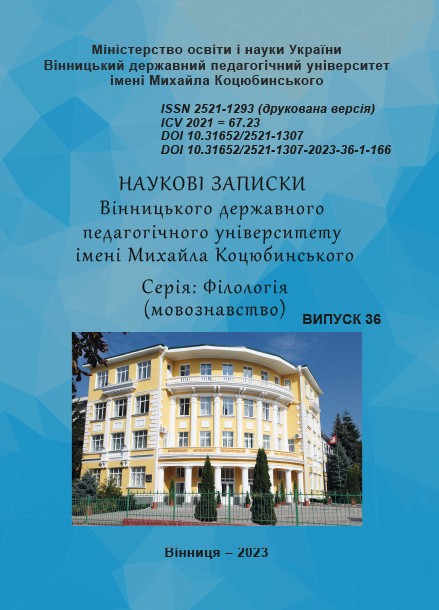Translation peculiarities of neologisms in wartime media texts
https://doi.org/10.31652/2521-1307-2022-36-148-156Published 2023-06-21
Keywords
- translation technique, translation transformation, neologism, emotional charge, media text
Copyright (c) 2023 Liudmyla Kovalchuk, Larysa Kyrychuk, Yuliia Litkovych

This work is licensed under a Creative Commons Attribution 4.0 International License.
How to Cite
Abstract
Introduction. War has always been a powerful trigger for the emergence of newly formed words in the vocabulary of any language. The Ukrainian language is no exception, and in the wake of Russia’s full-scale invasion of Ukraine in February 2022, it has been replenished with a significant number of neologisms. The Russian-Ukrainian war, which is still in the focus of the world community’s attention, has proven the multifaceted support of Ukraine in the international arena and has caused the appearance of numerous publications in the media space, including online publications in periodicals and posts on social media such as Facebook, Twitter, and Instagram. That is why the translation of neologisms from Ukrainian into English in wartime media texts is particularly relevant.
Purpose. The purpose of the article is to outline the main ways of translating into English emotionally charged neologisms that are inherent in wartime media texts.
Methods. The integrated study of neologisms in wartime media space and their translation from Ukrainian into English involved the application of the following methods: the method of continuous sampling (for assembling neologisms in wartime media texts), the method of descriptive observation (for clarifying possible ways of translating neologisms), methods of analysis and synthesis (for systematization and classification of neologisms of various part-of-speech and word- formation affiliation, singling out pragmatic and stylistic peculiarities of their translation, formulation of conclusions).
Results. The newly formed words and collocations in the Ukrainian language are mostly associated with well-known public figures and military leaders, military operations on the territory of certain geographical objects, names of weapons, etc. Some neologisms appeared only with the start of Russia’s full-scale invasion, while other already existing lexical items acquired new meanings.
The common characteristic feature of all wartime neologisms is their emotional colouring. As a living flexible organism language is able to absorb like a sponge all the negative and positive human emotions of the Russian-Ukrainian war. Each neologism of the Ukrainian language is a reflection of the military actions and related phenomena that are currently taking place on the territory of Ukraine, as well as a kind of container of various emotions experienced by Ukrainians working on different fronts to defend their homeland.
A significant layer of neologisms is emotionally loaded invective vocabulary, which serves as a kind of verbal means of liberation from the aggression caused by the Russian-Ukrainian war and finds its manifestation in swearing, mockery or cursing the occupiers.
According to the results of the study, the typical ways of creating neologisms include affixation, composition, telescopy and shortening. Due to a thorough analysis of wartime
neologisms in the Ukrainian and English media texts, it was found that the main translation techniques are transliteration, transcription, calquing, substitution, and explication. When dealing with catchphrases the most appropriate method is literary translation.
In addition, the stylistic features of translating neologisms in wartime media texts include pejorative grammar – decapitalized proper names, graphon – a deliberate distortion of the spelling norm, metaphorical antonomasia – the use of proper names of historical figures, literary or biblical characters having a certain characteristic feature; euphemisms – tolerant words or phrases used to replace unpleasant and obscene words, periphrases – descriptive naming of certain objects by highlighting their characteristic features.
Originality. The article presents the first attempt of making a deep insight into the translation peculiarities of the emotionally charged neologisms in wartime media texts.
Conclusion. The results of the study prove that, on the one hand, the emotionally charged wartime neologisms serve to name new realities and concepts, and on the other hand, reflect the rethinking of reality through the prism of the Russian-Ukrainian war, the figurative thinking and the impressive sense of the Ukrainian humour. The main techniques of translating neologisms from Ukrainian into English in wartime media texts include transliteration, transcription, calquing, substitution, explication and literal translation of catchphrases. Pejorative grammar, graphon, metaphorical antonomasia, euphemization, and periphrasis are effective stylistic tools aimed at fulfilling the pragmatic function of protesting against the war and ridiculing the occupiers. We consider further research of the possible ways of translating into English non-equivalent neologisms in modern military discourse to be much promising.
Downloads
References
- Герасімова О. Особливості перекладу мовних реалій як одиниць безеквівалентної лексики. Наукові записки Вінницького державного педагогічного університету імені Михайла Коцюбинського. Серія: Філологія (мовознавство): збірник наукових праць. Вінниця, 2015. Вип. 22. С. 242–246.
- Денисевич О., Плечко А. Емоційно-оцінний компонент в асоціативному значенні слова (на прикладі слів-стимулів рекламної лексики). Наукові записки Вінницького державного педагогічного університету імені Михайла Коцюбинського. Серія: Філологія (мовознавство): збірник наукових праць. Вінниця, 2021. Вип. 33. С. 50–58. https://doi.org/10.31652/2521-1307-2021-33-50-58
- Зацний Ю. А., Запольських С. П. Лінгвальні, соціолінгвальні та перекладацькі параметри нової лексики та фразеології англійської мови. Модуси сучасного перекладознавства / за ред. С. О. Швачко. Суми : Сумський державний університет, 2021 C. 13-41.
- Колодяжна Т. Ю. Актуальні проблеми перекладу неологізмів англійської мови. Наука онлайн: Міжнародний електронний журнал. 2018. № 6. URL: https://nauka-online.com/wp-content/uploads/2018/06/Kolodyazhna.pdf (дата звернення: 02.04.2023).
- Пуш О. М., Гасюк Н. В. Особливості перекладу військової термінології. Науковий вісник Міжнародного гуманітарного університету. Серія: Філологія. 2022. № 58. С. 305–308. https://doi.org/10.32841/2409-1154.2022.58.68
- Селіванова О. О. Сучасна лінгвістика: термінологічна енциклопедія. Полтава : Довкілля-К, 2006. 716 с.
- Kovalchuk L., Litkovych Yu. Psycholinguistic aspects of representing aggression in wartime media discourse. East European Journal of Psycholinguistics. Lutsk : Lesya Ukrainka Volyn National University, 2022. Vol. 9, No 2. P. 67–81. DOI: https://doi.org/10.29038/eejpl.2022.9.2.kov
- Mosiyevych L. The techniques of English-Ukrainian translation of military discourse. Jazyk a kultúra. Prešov : Lingvokulturologické a prekladateľsko-tlmočnícke centrum excelentnosti pri FF PU, 2017. Číslo 29-30. S. 112–117.





